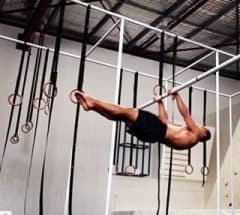Bodyweight training has recently become en vogue. In the fitness world it’s everywhere, it’s plastered all over social media, Functional Fitness areas are appearing in gyms, CrossFit boxes are employing Gymnastic Coaches, UFC fighters are employing Movement Coaches and doing Bodyweight training.
Here at Movement Co. it’s particularly relevant. We have three Full-time Bodyweight Coaches, a Strength and Conditioning Coach and CrossFit competitor, Parkour and Climbing Coaches.
Make no bones about it Bodyweight training is at this point in time a big thing.
But it’s not easy, it’s far more complex than using machines which guide you through a process.
For simpler Barbell movements once the form is correct it’s about repetitions, sets and weight. We can use sets and repetitions when training Bodyweight but our weight doesn’t change at will, so this complicates things.
Bodyweight training throws up a whole set of principles that most people will not have encountered before, let alone had to apply to themselves so it can be very confusing.
So here I am going to introduce some Fundamentals of Bodyweight training that will assist you in understanding what exactly it is that you are dealing with.
The Basics
Like anything Bodyweight training has it’s basic founding exercises that you will need to develop and strengthen before you move onto more difficult complex movements.
The basics we use here are the ability to do a Push-up, Pull-up, Squat, Dip, Hollow Body and the capacity to Hang.
Regardless of your athletic ability and background anybody doing Bodyweight training needs to go through these basic movements for strengthening & conditioning the body.
Length & Leverage
In Bodyweight training Length & Leverage is how we reduce or increase the amount of strength required to perform a movement.
In a Front Lever which is a Isometric hold performed on bars or gymnastic rings if your legs are tucked the Front Lever (pictured below) hold is far easier than if your legs are fully extended.
If I was to apply Leverage as a principle to a Front Lever then if my legs are not horizontal but instead aimed upwards towards the ceiling then once again the hold will become easier.
Simply when the body is longer or placed in a position where we have more surface area for gravity to work on the amount of strength required increases exponentially.

The Core is King with Bodyweight
Regardless of how strong we might be through the shoulders, chest, biceps, quads etc. without a strong midsection/core (and this doesn’t just mean six pack abs) you will struggle with Bodyweight training and are unlikely to progress much past the basics.
Having said that if you do start Bodyweight training it’s likely that you will develop a very strong core if you do the appropriate exercises.
The good thing about training the core muscles is that they will eventually be able to be worked more often than other parts of the body and they will recover quickly if you put the time in.
Range of Motion (ROM) is the key
For many Bodyweight exercises, mobility, flexibility and ROM play a massive part in determining how far you can progress.
Without having open shoulders, long hamstrings, shoulder elevation and the ability to compress ones body it is unlikely that you will ever be able to do a Straight arm Handstand Press from the floor.
It doesn’t really matter how strong you are if you don’t have the ROM it’s almost impossible.
ROM, flexibility and mobility also help Bulletproof the body from the potential of injury.
Protecting the Joints
This is a big one, in Bodyweight training a lot of the basic principles discussed above can cause repetitive strain injuries around the joints, a very common injury is Elbow Tendonitis.
Many people (myself included) make the mistake of getting far too excited when they initially start doing Bodyweight training and they literally smash themselves everyday until they develop conditions such as Elbow Tendonitis.
Once that happens it can become a frustrating period of therapy, resting, restarting training again only to break down again.
So a word to the wise here, regardless of how excited you are, allow your body that chance to rest and recover. Where muscles can gain strength quickly, joints, connective tissue, tendons & ligaments take far longer to become conditioned.
Slowly build up that strength and conditioning, vary your exercises and refrain from smashing the same things day in day out. If you feel like you are not recovering well enough give it a bit longer.
Your body will thank you for it. Bodyweight strength like any other form of strength building takes time and we are far better served if we are in it for the long haul.
Thanks
Jason
Calisthenics Coach

